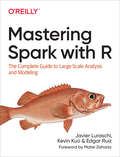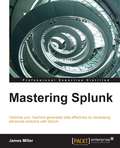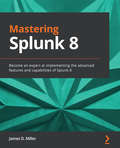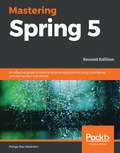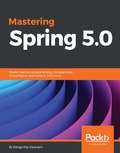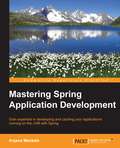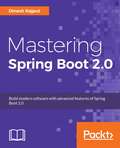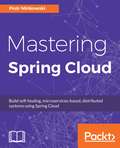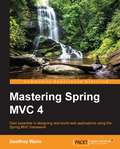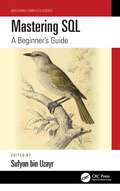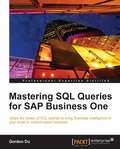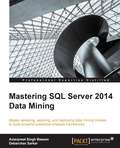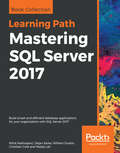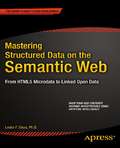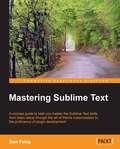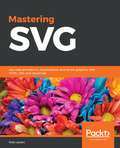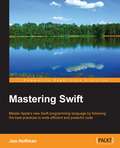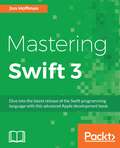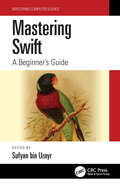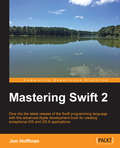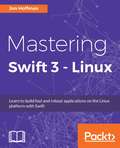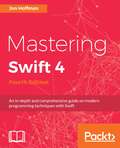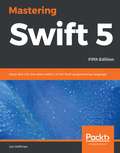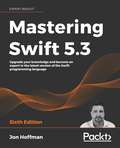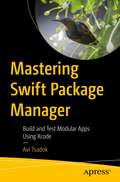- Table View
- List View
Mastering Spark with R: The Complete Guide to Large-Scale Analysis and Modeling
by Javier Luraschi Kevin Kuo Edgar RuizIf you’re like most R users, you have deep knowledge and love for statistics. But as your organization continues to collect huge amounts of data, adding tools such as Apache Spark makes a lot of sense. With this practical book, data scientists and professionals working with large-scale data applications will learn how to use Spark from R to tackle big data and big compute problems.Authors Javier Luraschi, Kevin Kuo, and Edgar Ruiz show you how to use R with Spark to solve different data analysis problems. This book covers relevant data science topics, cluster computing, and issues that should interest even the most advanced users.Analyze, explore, transform, and visualize data in Apache Spark with RCreate statistical models to extract information and predict outcomes; automate the process in production-ready workflowsPerform analysis and modeling across many machines using distributed computing techniquesUse large-scale data from multiple sources and different formats with ease from within SparkLearn about alternative modeling frameworks for graph processing, geospatial analysis, and genomics at scaleDive into advanced topics including custom transformations, real-time data processing, and creating custom Spark extensions
Mastering Splunk
by James MillerThis book is for those Splunk developers who want to learn advanced strategies to deal with big data from an enterprise architectural perspective. You need to have good working knowledge of Splunk.
Mastering Splunk 8: Become an expert at implementing the advanced features and capabilities of Splunk 8
by James D. MillerDelve into Splunk and extend intelligence capabilities, and leverage machine learning to explore data efficientlyKey FeaturesGain the expertise you need to implement the advanced features and capabilities of Splunk 8Get to grips with advanced Splunk features and create compelling reports and dashboardsDevelop and manage advanced Splunk pipelines to integrate intelligence capabilities within your organizationBook DescriptionSplunk is the most widely used engine for working with machine-generated data. This expert-level guide will help you to leverage advanced use cases to drive business growth using operational intelligence and business analytics features. You'll start with an introduction to the new features in Splunk 8 and cover step-by-step exercises that will help you to understand each feature in depth. Next, you'll explore key tasks such as workload management, performance and alerting, Splunk Enterprise Security, and advanced indexing. You'll also learn how to create categorical charts and run analytical operations on metrics within the Splunk Analytics workspace, before understanding how to deliver insights across your organization even when faced with limited or complex data using advanced data analytics. The book will also show you how to monitor and maintain Splunk environments using advanced dashboards. Later, you'll create custom data visualizations and update dashboards using drag and drop and the UI-based dashboard editor. Finally, you'll add SplunkJS to a web app and use the Splunk Machine Learning Toolkit (MLTK) as an extension to the core Splunk platform using real-world use cases. By the end of this book, you'll have learned how to use various Splunk features to extend intelligence capabilities and perform machine learning to explore data effectively.What you will learnUnderstand the components of Splunk 8 and how they workConvert distributed search environments to clusters and configure disaster recovery sites using index clusteringFind out how to integrate Splunk with platforms such as AWS and Microsoft AzureUse Search Processing Language (SPL) within Splunk macros to create efficient searchingDetect suspicious patterns in data with advanced event correlation searchesExplore machine learning with Splunk MLTKReview the beta dashboard editor using working examplesUse SplunkJS Stack libraries to enhance web appsWho this book is forThis Splunk book is for data professionals, data analysts, and Splunk users looking to leverage the advanced features of the Splunk Enterprise platform to derive valuable business insights from machine data. The book is also a useful expert-level guide for individuals from all facets of IT, business, and security. Prior knowledge of Splunk and its features is mandatory to get the most out of this book.
Mastering Spring 5: An effective guide to build enterprise applications using Java Spring and Spring Boot framework, 2nd Edition
by Ranga Rao KaranamBuild scalable and flexible Rest APIs and microservices using the latest versions of Spring and Spring Boot Key Features Build Java-based enterprise applications using Spring 5.1 and Spring Boot 2.1 Create high performing, reusable, and scalable enterprise Java applications that are easy to test Gain powerful insights into advanced Spring and Spring Boot concepts to develop applications effectively Book Description Spring 5.1 is the latest release of the widely used Spring Framework. This book takes you through the evolution of building enterprise-ready applications with Spring and Spring Boot. Mastering Spring 5 starts with an overview of some of the important Spring Framework features relating to aspect-oriented programming, task scheduling, and scripting with the help of practical examples. You'll learn about the standard dependency injection specification for Java contexts and CDI and how the Spring Framework supports it. You'll gain an understanding of how application architectures have evolved from monoliths to microservices and be able to build your own microservices using Spring Boot. Complete with real-world examples, this book will help you gain powerful insights into Spring Boot 2.1 and learn how to develop cloud-native microservices with Spring Cloud. You'll even explore how to secure a REST API with Spring Security and get started with your first full stack application using React. Furthermore, you'll get to grips with Kotlin fundamentals and build a Kotlin project in Eclipse. By the end of this book, you'll be equipped with all the knowledge required to develop microservices and full stack applications with the Spring Framework. What you will learn Explore Spring Framework 5.1 features such as AOP, transaction management, task scheduling, and scripting Build REST APIs and microservices with Spring and Spring Boot Develop a secure REST API with Spring Security Build your first full stack React application Write efficient unit tests with Spring and Spring Boot Understand the advanced features that Spring Boot offers to develop and monitor applications Use Spring Cloud to deploy and manage applications on the Cloud Who this book is for This book is for experienced Java and enterprise Java developers and programmers who have a basic understanding of the Spring Framework.
Mastering Spring 5.0
by Ranga Rao KaranamDevelop cloud native applications with microservices using Spring Boot, Spring Cloud, and Spring Cloud Data Flow About This Book • Explore the new features and components in Spring • Evolve towards micro services and cloud native applications • Gain powerful insights into advanced concepts of Spring and Spring Boot to develop applications more effectively • Understand the basics of Kotlin and use it to develop a quick service with Spring Boot Who This Book Is For This book is for an experienced Java developer who knows the basics of Spring, and wants to learn how to use Spring Boot to build applications and deploy them to the cloud. What You Will Learn • Explore the new features in Spring Framework 5.0 • Build microservices with Spring Boot • Get to know the advanced features of Spring Boot in order to effectively develop and monitor applications • Use Spring Cloud to deploy and manage applications on the Cloud • Understand Spring Data and Spring Cloud Data Flow • Understand the basics of reactive programming • Get to know the best practices when developing applications with the Spring Framework • Create a new project using Kotlin and implement a couple of basic services with unit and integration testing In Detail Spring 5.0 is due to arrive with a myriad of new and exciting features that will change the way we've used the framework so far. This book will show you this evolution—from solving the problems of testable applications to building distributed applications on the cloud. The book begins with an insight into the new features in Spring 5.0 and shows you how to build an application using Spring MVC. You will realize how application architectures have evolved from monoliths to those built around microservices. You will then get a thorough understanding of how to build and extend microservices using Spring Boot. You will also understand how to build and deploy Cloud-Native microservices with Spring Cloud. The advanced features of Spring Boot will be illustrated through powerful examples. We will be introduced to a JVM language that's quickly gaining popularity - Kotlin. Also, we will discuss how to set up a Kotlin project in Eclipse. By the end of the book, you will be equipped with the knowledge and best practices required to develop microservices with the Spring Framework. Style and Approach This book follows an end-to-end tutorial approach with lots of examples and sample applications, covering the major building blocks of the Spring framework.
Mastering Spring Application Development
by Anjana MankaleIf you are a Java developer with experience in developing applications with Spring, then this book is perfect for you. A good working knowledge of Spring programming conventions and applying dependency injections is recommended to make the most of this book.
Mastering Spring Boot 2.0: Build modern, cloud-native, and distributed systems using Spring Boot
by Dinesh RajputLearn to develop, test, and deploy your Spring Boot distributed application and explore various best practices.Key Features- Build and deploy your microservices architecture in the cloud- Build event-driven resilient systems using Hystrix and Turbine- Explore API management tools such as KONG and API documentation tools such as SwaggerBook DescriptionSpring is one of the best frameworks on the market for developing web, enterprise, and cloud ready software. Spring Boot simplifies the building of complex software dramatically by reducing the amount of boilerplate code, and by providing production-ready features and a simple deployment model.This book will address the challenges related to power that come with Spring Boot's great configurability and flexibility. You will understand how Spring Boot configuration works under the hood, how to overwrite default configurations, and how to use advanced techniques to prepare Spring Boot applications to work in production. This book will also introduce readers to a relatively new topic in the Spring ecosystem – cloud native patterns, reactive programming, and applications. Get up to speed with microservices with Spring Boot and Spring Cloud. Each chapter aims to solve a specific problem or teach you a useful skillset. By the end of this book, you will be proficient in building and deploying your Spring Boot application.What you will learn Build logically structured and highly maintainable Spring Boot applications Configure RESTful microservices using Spring Boot Make the application production and operation-friendly with Spring Actuator Build modern, high-performance distributed applications using cloud patterns Manage and deploy your Spring Boot application to the cloud (AWS) Monitor distributed applications using log aggregation and ELKWho this book is forThe book is targeted at experienced Spring and Java developers who have a basic knowledge of working with Spring Boot. The reader should be familiar with Spring Boot basics, and aware of its benefits over traditional Spring Framework-based applications.
Mastering Spring Cloud: Build self-healing, microservices-based, distributed systems using Spring Cloud
by Piotr MińkowskiLearn how to build, test, secure, deploy, and efficiently consume services across distributed systems.Key Features- Explore the wealth of options provided by Spring Cloud for wiring service dependencies in microservice systems.- Create microservices utilizing Spring Cloud's Netflix OSS- Architect your cloud-native data using Spring Cloud.Book DescriptionDeveloping, deploying, and operating cloud applications should be as easy as local applications. This should be the governing principle behind any cloud platform, library, or tool. Spring Cloud–an open-source library–makes it easy to develop JVM applications for the cloud. In this book, you will be introduced to Spring Cloud and will master its features from the application developer's point of view. This book begins by introducing you to microservices for Spring and the available feature set in Spring Cloud. You will learn to configure the Spring Cloud server and run the Eureka server to enable service registration and discovery. Then you will learn about techniques related to load balancing and circuit breaking and utilize all features of the Feign client. The book now delves into advanced topics where you will learn to implement distributed tracing solutions for Spring Cloud and build message-driven microservice architectures. Before running an application on Docker container s, you will master testing and securing techniques with Spring Cloud.What you will learn- Abstract Spring Cloud's feature set- Create microservices utilizing Spring Cloud's Netflix OSS- Create synchronous API microservices based on a message-driven architecture.- Explore advanced topics such as distributed tracing, security, and contract testing.- Manage and deploy applications on the production environment Who this book is forThis book appeals to developers keen to take advantage of Spring cloud, an open source library which helps developers quickly build distributed systems. Knowledge of Java and Spring Framework will be helpful, but no prior exposure to Spring Cloud is required.
Mastering Spring MVC 4
by Geoffroy WarinGain expertise in designing real-world web applications using the Spring MVC framework About This Book * Design your own Spring web applications using tools such as Spring Boot and Spring Tool Suite * Secure your developments with easy-to-write, reliable unit and end-to-end tests * Deploy your application on the cloud for free and invite the whole world to see Who This Book Is For This book is perfect for developers who are familiar with the fundamentals of Spring programming and are eager to deepen their web development skills. Prior knowledge of the Spring MVC framework is recommended. What You Will Learn * Set up your own web application using Spring Boot and Spring Tool Suite * Discover the MVC architecture and the different tools along with navigating between views * Design complex advanced-level forms and validate the model * Craft a RESTful application with a meaningful API and error messages * Create maintainable unit and acceptance tests * Secure your application while allowing it to scale * Optimize your requests with caching, ETags, and asynchronous responses * Deploy the web application to the cloud in a snap In Detail Spring MVC is the ideal tool to build modern web applications on the server side. With the arrival of Spring Boot, developers can really focus on the code and deliver great value, leveraging the rich Spring ecosystem with minimal configuration. Spring makes it simple to create RESTful applications, interact with social services, communicate with modern databases, secure your system, and make your code modular and easy to test. It is also easy to deploy the result on different cloud providers. Mastering Spring MVC will take you on a journey from developing your own web application to uploading it on the cloud. You begin by generating your own Spring project using Spring Tool suite and Spring Boot. As you develop an advanced-level interactive application that can handle file uploads as well as complex URLs, you will dive into the inner workings of Spring MVC and the principles of modern web architectures. You will then test, secure, and optimize your Spring web application and design RESTful services that will be consumed on the frontend. Finally, when everything is ready, you will release your application on a cloud provider and invite everyone to see. Style and approach An iterative hands-on approach in a conversational and easy-to-follow style. Each chapter will improve on the work done in the previous one until the application is ready to be released.
Mastering SQL: A Beginner's Guide (Mastering Computer Science)
by Sufyan Bin UzayrMastering SQL helps readers gain a firm understanding of the Structured Query Language. Structured Query Language, more often known as SQL, is the de facto standard language for working with databases. It is a specialized language for handling data-related tasks like creating a database, putting information into tables, modifying and extracting that information, and much more. MySQL, PostgreSQL, Oracle, SQL light, etc. are only a few examples of SQL implementations. SQL is a fast and efficient database system. SQL allows for the rapid and efficient retrieval of huge numbers of data entries from a database. It’s a relational database. Thus, data is described in a more orderly fashion than in an unstructured database like MongoDB. Insertions, deletions, inquiries, manipulations, and computations of data through analytical queries in a relational database may all be performed in a matter of seconds. With Mastering SQL, learning SQL becomes straightforward; using this book and resource will undoubtedly help readers advance their careers. The Mastering Computer Science series is edited by Sufyan bin Uzayr, a writer and educator with over a decade of experience in the computing field.
Mastering SQL Queries for SAP Business One
by Gordon DuThis is a practical guide providing comprehensive solutions for SQL query problems, and is full of concrete real-world examples to help you create and troubleshoot your SQL queries in SAP Business One. If you are a system administrator who uses SQL query as your tool of choice for solving specific problems throughout SAP Business One, then this book is for you. It may also be useful if you are a developer or consultant using this technology, and can benefit end users by improving your search for important business information. A rudimentary knowledge of SAP Business One and SQL Server is required to use this book efficiently. Examples covered are relevant to SBO 2007A users, for which the 8.8 release is mostly compatible. All SQL query examples within the book are verified under SQL Server 2005, so they are guaranteed to run under this release, in addition to SQL Server 2008. Non-SAP Business One users can also gain knowledge from the many examples throughout the book. It is hard to find another book with so many SQL query examples.
Mastering SQL Server 2014 Data Mining
by Amarpreet Singh Bassan Debarchan SarkarIf you are a developer who is working on data mining for large companies and would like to enhance your knowledge of SQL Server Data Mining Suite, this book is for you. Whether you are brand new to data mining or are a seasoned expert, you will be able to master the skills needed to build a data mining solution.
Mastering SQL Server 2017: Build smart and efficient database applications for your organization with SQL Server 2017
by Milos Radivojevic Dejan Sarka William Durkin Christian Cote Matija LahLeverage the power of SQL Server 2017 Integration Services to build data integration solutions with ease Key Features Work with temporal tables to access information stored in a table at any time Get familiar with the latest features in SQL Server 2017 Integration Services Program and extend your packages to enhance their functionality Book Description Microsoft SQL Server 2017 uses the power of R and Python for machine learning and containerization-based deployment on Windows and Linux. By learning how to use the features of SQL Server 2017 effectively, you can build scalable apps and easily perform data integration and transformation. You'll start by brushing up on the features of SQL Server 2017. This Learning Path will then demonstrate how you can use Query Store, columnstore indexes, and In-Memory OLTP in your apps. You'll also learn to integrate Python code in SQL Server and graph database implementations for development and testing. Next, you'll get up to speed with designing and building SQL Server Integration Services (SSIS) data warehouse packages using SQL server data tools. Toward the concluding chapters, you'll discover how to develop SSIS packages designed to maintain a data warehouse using the data flow and other control flow tasks. By the end of this Learning Path, you'll be equipped with the skills you need to design efficient, high-performance database applications with confidence. This Learning Path includes content from the following Packt books: SQL Server 2017 Developer's Guide by Milos Radivojevic, Dejan Sarka, et. al SQL Server 2017 Integration Services Cookbook by Christian Cote, Dejan Sarka, et. al What you will learn Use columnstore indexes to make storage and performance improvements Extend database design solutions using temporal tables Exchange JSON data between applications and SQL Server Migrate historical data to Microsoft Azure by using Stretch Database Design the architecture of a modern Extract, Transform, and Load (ETL) solution Implement ETL solutions using Integration Services for both on-premise and Azure data Who this book is for This Learning Path is for database developers and solution architects looking to develop ETL solutions with SSIS, and explore the new features in SSIS 2017. Advanced analysis practitioners, business intelligence developers, and database consultants dealing with performance tuning will also find this book useful. Basic understanding of database concepts and T-SQL is required to get the best out of this Learning Path.
Mastering Structured Data on the Semantic Web
by Leslie F. SikosA major limitation of conventional web sites is their unorganized and isolated contents, which is created mainly for human consumption. This limitation can be addressed by organizing and publishing data, using powerful formats that add structure and meaning to the content of web pages and link related data to one another. Computers can "understand" such data better, which can be useful for task automation. The web sites that provide semantics (meaning) to software agents form the Semantic Web, the Artificial Intelligence extension of the World Wide Web. In contrast to the conventional Web (the "Web of Documents"), the Semantic Web includes the "Web of Data", which connects "things" (representing real-world humans and objects) rather than documents meaningless to computers. Mastering Structured Data on the Semantic Web explains the practical aspects and the theory behind the Semantic Web and how structured data, such as HTML5 Microdata and JSON-LD, can be used to improve your site''s performance on next-generation Search Engine Result Pages and be displayed on Google Knowledge Panels. You will learn how to represent arbitrary fields of human knowledge in a machine-interpretable form using the Resource Description Framework (RDF), the cornerstone of the Semantic Web. You will see how to store and manipulate RDF data in purpose-built graph databases such as triplestores and quadstores, that are exploited in Internet marketing, social media, and data mining, in the form of Big Data applications such as the Google Knowledge Graph, Wikidata, or Facebook''s Social Graph. With the constantly increasing user expectations in web services and applications, Semantic Web standards gain more popularity. This book will familiarize you with the leading controlled vocabularies and ontologies and explain how to represent your own concepts. After learning the principles of Linked Data, the five-star deployment scheme, and the Open Data concept, you will be able to create and interlink five-star Linked Open Data, and merge your RDF graphs to the LOD Cloud. The book also covers the most important tools for generating, storing, extracting, and visualizing RDF data, including, but not limited to, Protégé, TopBraid Composer, Sindice, Apache Marmotta, Callimachus, and Tabulator. You will learn to implement Apache Jena and Sesame in popular IDEs such as Eclipse and NetBeans, and use these APIs for rapid Semantic Web application development. Mastering Structured Data on the Semantic Web demonstrates how to represent and connect structured data to reach a wider audience, encourage data reuse, and provide content that can be automatically processed with full certainty. As a result, your web contents will be integral parts of the next revolution of the Web. What you''ll learn Extend your markup with machine-readable annotations and get your data to the Google Knowledge Graph Represent real-world objects and persons with machine-interpretable code Develop Semantic Web applications in Java Reuse and interlink structured data and create LOD datasets Who this book is for The book is intended for web developers and SEO experts who want to learn state-of-the-art Search Engine Optimization methods using machine-readable annotations and machine-interpretable Linked Data definitions. The book will also benefit researchers interested in automatic knowledge discovery. As a textbook on Semantic Web standards powered by graph theory and mathematical logic, the book could also be used as a reference work for computer science graduates and Semantic Web researchers. Table of Contents 1. Introduction to the Semantic Web 2. Knowledge Representation 3. Linked Open Data 4. Semantic Web Development Tools 5. Semantic Web Services 6. Graph Databases 7. Querying 8. Big Data Applications 9. Use Cases
Mastering Sublime Text
by Dan PelegMastering Sublime Text is an easy-to-understand, step-by-step guide for learning all of the features of Sublime Text, including author tips and tricks. Every topic includes code examples and highlighted screenshots to make it easier to understand.This book is for developers with experience in any type of programming language, and for those who want to start using Sublime Text or perfect their existing skills. No knowledge of Sublime Text or any other code editor or IDE is expected.
Mastering SVG: Ace web animations, visualizations, and vector graphics with HTML, CSS, and JavaScript
by Rob LarsenTake the plunge and develop cross-browser-compatible and responsive web designs with SVGKey FeaturesMaster the art of custom animations and visualizations with SVG, CSS, and JavaScriptCombine SVG with third-party libraries and frameworks such as React, JQuery, D3, and Snap.svg for GUI-rich appsCreate an awesome user experience with high-performance graphics for your web applicationsBook DescriptionSVG is the most powerful image format in use on the web. In addition to producing resolution-independent images for today's multi-device world, SVG allows you to create animations and visualizations to add to your sites and applications. The simplicity of cross-platform markup, mixed with familiar modern web languages, such as CSS and JavaScript, creates a winning combination for designers and developers alike.In this book, you will learn how to author an SVG document using common SVG features, such as elements and attributes, and serve SVG on the web using simple configuration tips for common web servers. You will also use SVG elements and images in HTML documents.Further, you will use SVG images for a variety of common tasks, such as manipulating SVG elements, adding animations using CSS, mastering the basic JavaScript SVG (API) using Document Object Model (DOM) methods, and interfacing SVG with common libraries and frameworks, such as React, jQuery, and Angular.You will then build an understanding of the Snap.svg and SVG.js APIs, along with the basics of D3, and take a look at how to implement interesting visualizations using the library. By the end of the book, you will have mastered creating animations with SVG.What you will learnDeliver the elements that make up an SVG image Replace your old CSS sprites with SVGUnderstand animation and data visualization with SVG are explained in pure JavaScript and using common librariesUse SVG to scale images across multiple devices easily Harness the power of CSS animations and transformations to manipulate your SVG images in a replicable, remixable wayInterface SVG with common libraries and frameworks, such as jQuery, React, and AngularWho this book is forThis book is for web developers and designers looking to add animation to their projects. Some experience with HTML, CSS, and JavaScript is required.
Mastering Swift
by Jon HoffmanIf you are a developer that learns best by looking at, and working with, code, then this book is for you. A basic understanding of Apple's tools is beneficial but not mandatory.
Mastering Swift
by Jon HoffmanIf you are a developer that learns best by looking at, and working with, code, then this book is for you. A basic understanding of Apple's tools is beneficial but not mandatory.
Mastering Swift: A Beginner's Guide (Mastering Computer Science)
by Sufyan Bin UzayrIf you want to become an iOS developer, you have made an excellent choice with this book. Swift holds a significant position in the iOS industry because of the long list of features it serves. It is user-friendly, has great community support, and offers a greater extent of customization. As a result, we can observe a sharp increase in the market demand for developing Apple mobile applications, and with that, companies search for smart developers with the right skill set. Mastering Swift introduces Apple’s excellent Swift standard library style and incorporates usage feedback across multiple Swift projects. However, it should be regarded as a living, changeable document and the basis upon which the programming language is implemented. Before going further into the details of the Swift programming language, the book briefly explains the basic information about the language. It is a high-level language created to develop multifaceted iOS applications that cater to diverse needs of different social and business domains. It is meant to develop high-end apps with multiple complexities. But since it is very close to Objective C, it is easy to code and understand. This feature also makes it incredibly friendly to beginners. Moreover, it is equally compatible with the iPhone, the iPad, Apple Watch, MacBook, and Apple TV, and it can be applied to develop equally efficient and scalable apps for them. This book in the Mastering series encircles all the essential aspects of Swift and explores why this programming language is the future for iOS app development. Different from other languages, it requires fewer lines to activate any feature. This paves the way for a shorter development cycle and saves a lot of precious resources. Further, as one of the most reliable iOS programming languages it supports dynamic libraries that indicate executable bits of code that you can link to an application. Because of such support, Swift apps can interoperate with the newest version of the language to make the app irreplaceable. Swift is a language that was not designed but deliberately made open source so as to invite community input, allowing the product to grow and to mature over the years. This could possibly be the most crucial aspect of Swift. As people become more aware of its potential to be used in servers, web frameworks were more willing to support the demand. Owing to its popularity and significance, its adoption rate in Apple’s rivals remains very high. Whether you are a beginner or an advanced learner, if you are planning for iOS app development through Swift, this book can help with the high-domain expertise and experienced resources. Without a doubt, the developers that create native apps are not going to abandon Swift anytime soon. However, it seems like something must evolve for it to keep growing constantly. We believe that Swift is indeed the future for iOS app developers. And if you are convinced and want to start learning the programming language right away, then this book is what you’re looking for. Learn more about our other Mastering titles at: https://www.routledge.com/Mastering-Computer-Science/book-series/MCS
Mastering Swift 2
by Jon HoffmanDive into the latest release of the Swift programming language with this advanced Apple development book for creating exceptional iOS and osX applicationsAbout This BookHarness the latest and most advanced features of Swift 2 to develop quality iOS and OSX applicationsComprehensive coverage of all the advanced features of Swift and guidance on advanced design techniquesDive deep into protocol extensions, learn new error handling model, and use featured Swift design patterns to write more efficient codeWho This Book Is ForThis book is for developers that want to dive into the newest version of Swift. If you want in-depth knowledge of some of the most sophisticated elements of Swift development including protocol extensions, error-handling, design patterns, and concurrency, Mastering Swift 2 gives you guidance on how to use and apply them in your own projects.What You Will LearnDive into the core components of Swift 2 including operators, collections, control flow, and functionsCreate and use classes, structures, and enums including object-oriented topics such as inheritance, protocols, and extensionsDevelop a practical understanding of subscripts, optionals, and closuresLearn how to use the new protocol extension and error handling features of Swift 2Add concurrency to your applications using Grand Central DispatchMaster Objective-C interoperability with Mix and MatchAccess network resources using SwiftImplement various standard design patterns in the Swift languageIn DetailAt their Worldwide Developer's conference (WWDC) in 2015, Apple announced Swift 2, a major update to the innovative programming language they first unveiled to the world the year before. Swift 2 features exciting enhancements to the original iteration of Swift, acting, as Apple put it themselves as “a successor to the C and Objective-C languages.” – This book demonstrates how to get the most from these new features, and gives you the skills and knowledge you need to develop dynamic iOS and OS X applications.Learn how to harness the newest features of Swift 2 todevelop advanced applications on a wide range of platforms with this cutting-edge development guide. Exploring and demonstrating how to tackle advanced topics such as Objective-C interoperability, ARC, closures, and concurrency, you'll develop your Swift expertise and become even more fluent in this vital and innovative language. With examples that demonstrate how to put the concepts into practice, and design patterns and best practices, you'll be writing better iOS and OSX applications in with a new level of sophistication and control.Style and approachThis book takes an example-based approach where each concept covered is supported by example code to not only give you a good understanding of the concept, but also to demonstrate how to properly implement it.
Mastering Swift 3 - Linux
by Jon HoffmanLearn to build fast and robust applications on the Linux platform with Swift About This Book • Create robust applications by building a strong foundation in the Swift Language • Utilize Swift 3 on the embedded Linux platform for IoT and Robotic projects • Build more flexible and high-performing applications on desktop, server, and embedded Linux platforms Who This Book Is For This book is for Linux developers who are interested in quickly learning how to use Swift to create exciting applications on Linux platforms. What You Will Learn • Install Swift on the Linux platform • Explore the power of the Swift language • Get to know the proper design techniques • Understand Swift's new Core Library • Implement popular design patterns with Swift • Integrate C libraries with Swift • Using Swift on Single-Board Computers • Learn how to add concurrency to your application with Grand Central Dispatch • Learn how to work with Swift Generics • Learn how to use the Protocol-Oriented design paradigm In Detail Swift is a modern, fast, and safe programming language created by Apple. Writing Swift is interactive and fun, the syntax is concise yet expressive, and the code runs lightning-fast. Swift's move to open source has been embraced with open arms and has seen increased adoption in the Linux platform. Our book will introduce you to the Swift language, further delving into all the key concepts you need to create applications for desktop, server, and embedded Linux platforms. We will teach you the best practices to design an application with Swift 3 via design patterns and Protocol-Oriented Programming. Further on, you will learn how to catch and respond to errors within your application. When you have gained a strong knowledge of using Swift in Linux, we'll show you how to build IoT and robotic projects using Swift on single board computers. By the end of the book, you will have a solid understanding of the Swift Language with Linux and will be able to create your own applications with ease. Style and approach This easy-to-follow, code-rich guide is filled with examples that demonstrate how to put the concepts into practice. You'll also get design patterns and best practices to get you writing better applications on the Linux platform.
Mastering Swift 4 - Fourth Edition
by Jon HoffmanDive into the latest release of the Swift programming language with this advanced development book for building highly performant applications. About This Book • Harness the latest and most advanced features of Swift 4 to develop quality iOS and macOS applications • Comprehensive coverage of all the advanced features of Swift and guidance on advanced design techniques • Dive deep into protocol extensions, learn new error handling model, and use featured Swift design patterns to write more efficient code • Get to grips with advanced design techniques to write smarter, cleaner Swift code Who This Book Is For This book is for developers who want to delve into the newest version of Swift. If you are a developer who learns best by looking at and working with code, then this book is for you. A basic understanding of Apple's tools is beneficial but not mandatory. What You Will Learn • Delve into the core components of Swift 4.0, including operators, collections, control flows, and functions • Create and use classes, structures, and enumerations • Understand protocol-oriented design and see how it can help you write better code • Develop a practical understanding of subscripts and extensions • Add concurrency to your applications using Grand Central Dispatch and Operation Queues • Implement generics and closures to write very flexible and reusable code • Make use of Swift's error handling and availability features to write safer code In Detail Swift is the definitive language for Apple development today. It's a vital part of any iOS and macOS developer's skillset, helping them to build the most impressive and popular apps on the App Store—the sort of apps that are essential to iPhone and iPad users every day. With version 4.0, the Swift team has added new features to improve the development experience, making it easier to get the results you want and customers expect. Inside, you'll find the key features of Swift 4.0 and quickly learn how to use the newest updates to your development advantage. From Objective-C interoperability and ARC to closures and concurrency, this advanced Swift guide will develop your expertise and help you become fluent in this vital programming language. We'll give you an in-depth knowledge of some of the most sophisticated elements of Swift development, including protocol extensions, error-handling, design patterns, and concurrency. We'll guide you on how to use and apply them in your own projects. You'll see how to leverage the power of protocol-oriented programming to write flexible and easier-to-manage code. Style and Approach A Step-by-step advanced guide
Mastering Swift 5: Deep dive into the latest edition of the Swift programming language, 5th Edition
by Jon HoffmanHarness the power of the latest edition with this in-depth and comprehensive guide to the Swift languageKey FeaturesFifth edition of this bestselling book, improved and updated to cover the latest version of the Swift 5 programming languageGet to grips with popular and modern design techniques to write easy-to-manage Swift codeLearn how to use core Swift features such as concurrency, generics, and copy-on-write in your codeBook DescriptionOver the years, the Mastering Swift book has established itself amongst developers as a popular choice as an in-depth and practical guide to the Swift programming language. The latest edition is fully updated and revised to cover the new version: Swift 5.Inside this book, you'll find the key features of Swift 5 easily explained with complete sets of examples. From the basics of the language to popular features such as concurrency, generics, and memory management, this definitive guide will help you develop your expertise and mastery of the Swift language.Mastering Swift 5, Fifth Edition will give you an in-depth knowledge of some of the most sophisticated elements in Swift development, including protocol extensions, error handling, and closures. It will guide you on how to use and apply them in your own projects.Later, you'll see how to leverage the power of protocol-oriented programming to write flexible and easier-to-manage code. You will also see how to add the copy-on-write feature to your custom value types and how to avoid memory management issues caused by strong reference cycles.What you will learnUnderstand core Swift components, including operators, collections, control flows, and functionsLearn how and when to use classes, structures, and enumerationsUnderstand how to use protocol-oriented design with extensions to write easier-to-manage codeUse design patterns with Swift, to solve commonly occurring design problemsImplement copy-on-write for you custom value types to improve performanceAdd concurrency to your applications using Grand Central Dispatch and Operation QueuesImplement generics to write flexible and reusable codeWho this book is forThis book is for developers who want to delve into the newest version of Swift. If you are a developer and learn best by looking at and working with code, then this book is for you. A basic understanding of Apple's tools would be beneficial but not mandatory. All examples should work on the Linux platform as well.
Mastering Swift 5.3: Upgrade your knowledge and become an expert in the latest version of the Swift programming language, 6th Edition
by Jon HoffmanA comprehensive guide for programming enthusiasts who wish to gain a firm command of the fundamentals and advanced Swift conceptsKey FeaturesSixth edition of this bestselling book, improved and updated to cover the latest version of the Swift 5.3 programming languageGet to grips with popular and modern design techniques to write easy-to-manage Swift codeUse core Swift features such as concurrency, generics, and copy-on-write in your codeBook DescriptionOver the years, Mastering Swift has proven itself among developers as a popular choice for an in-depth and practical guide to the Swift programming language. This sixth edition comes with the latest features, an overall revision to align with Swift 5.3, and two new chapters on building swift from source and advanced operators.From the basics of the language to popular features such as concurrency, generics, and memory management, this in-depth guide will help you develop your expertise and mastery of the language.As you progress, you will gain practical insights into some of the most sophisticated elements in Swift development, including protocol extensions, error handling, and closures. The book will also show you how to use and apply them in your own projects. In later chapters, you will understand how to use the power of protocol-oriented programming to write flexible and easier-to-manage code in Swift. Finally, you will learn how to add the copy-on-write feature to your custom value types, along with understanding how to avoid memory management issues caused by strong reference cycles.By the end of this Swift book, you will have mastered the Swift 5.3 language and developed the skills you need to effectively use its features to build robust applications.What you will learnUnderstand core Swift components, such as operators, collections, control flows, and functionsIdentify how and when to use classes, structures, and enumerationsUse protocol-oriented design with extensions to write easy-to-manage codeLeverage design patterns with Swift to solve commonly occurring design problemsApply copy-on-write for your custom value types to improve performanceAdd concurrency to your applications using Grand Central Dispatch and operation queuesImplement generics to write flexible and reusable codeWho this book is forThis book is for beginners with a basic understanding of programming and experienced developers looking to learn Swift programming. Familiarity with Apple's tools will be beneficial but not mandatory. All examples should also work on the Linux and Windows platforms
Mastering Swift Package Manager: Build and Test Modular Apps Using Xcode
by Avi TsadokMaintaining an iOS project often results in thousands of code files scattered around your folders. Did you ever wanted to reuse those files with other projects but found yourself making copies of Swift files? You are not alone! Many iOS developers struggle with this issue as well—unorganized projects, duplicated files, difficulty in testing, and long complication times. This book will show how Swift Package Manager can help you handle these problems by restructuring your project to make it efficient and straightforward. Swift Package Manager isn’t magic, but you’ll likely need a little guidance in using this nifty tool. You'll see how to reorganize projects smartly and efficiently, create your first Swift package, and learn what libraries are in this context. Then share your package with the rest of your projects. Next test your library’s quality. And then take your library to the next level of power by including files that go beyond just code. By going over the methodology of big project organization, you will have the ability to extend your project into the future as Apple sees it. Make no mistake—the path for a modular and flexible project is not easy. With the help of Swift Package Manager, it becomes possible and worth it. What You'll LearnCreate a Swift package both from the command line and from Xcode Manage Swift packages in public and private Git repositories Build test suites to test integrations between packagesWho This Book Is For Senior iOS developers and team leaders who already have professional experience with Swift.
